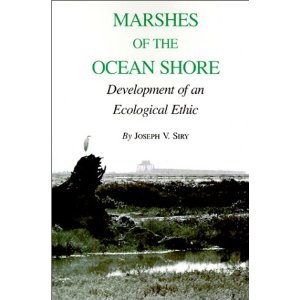What makes some kinds of landscape more important or equally as important as other terrains?
marshes and productivity | economic value of landscape | an ecological perspective | Rachel Carson's role | A regional view | Conclusion
 An illustrated chapter 6.
An illustrated chapter 6.
6, The New Ecology and The New Ecological Ethic
7, Estuaries and The New Ecology
"At the turn of the century ecology and economics agreed on the classification of tidal marshes as obstructing wastelands. Resource economics determined the 'best' use of land solely from human and utilitarian perspectives. The initial findings of terrestrial and marine biologists supported policies to make human 'improvements' over nature's perceived inefficiency. However, in The 1930s and 1940s a number of scientists, including wildlife biologist, Aldo Leopold, would begin to demonstrate that The political and economic values assigned to coastal wetlands and other wild areas conflicted with their biological integrity."
Key Players
Review of Chapter Six's main points:
Aldo Leopold and the new ecology
Tidelands Oil Controversy
A growing ecological revolt was based on:
 7, Estuaries and The New Ecology
7, Estuaries and The New Ecology
"The expansion of wisdom is a difficult task for an individual,
let alone a society. In
democratic cultures wisdom often may be overlooked at the voting boot in the
formulation of policy. For citizens and civil servants alike, confronting popular
notions of efficacy and justice takes courage. Rachel Louise Carson was an advocate
of unpopular causes, including fish and bird protection, preservation of wild
seashores, and opposition to heedless use of 'miracle' technologies. Her final,
best known attack on the indiscriminate uses of DDT as an insecticide was only
one part of her larger and more positive view of the world and humanity's place
in the eco-energetic scheme.... More than any other scientist she popularized the oceans and the shores, with a profoundly religious respect for nature and
a practical appreciation for human ignorance. A contemporary of her fellow preservation
ecologist, Aldo Leopold, Carson focused more explicitly than he on oceans and
shores."
Land Ethic
Key Players
Review of Chapter Seven's main points:
Rachel Carson's tradition 1937-1668.
p. 141.
City Planning and scenic preservation in 1920sFederal Conservation Policy reformulation by Herbert Hoover and then some continuity and expansion of concepts like zoning and comprehensive riverine management from Hoover to Ickes coupled with the slow development of fisheries and wildlife protection in the 1930s led to the creation of the U.S. Fish and Wildlife Service in the 1940s.
The role of Rachel Carson's books in raising popular awareness.
 Carson in the US Fish and Wildlife Service
Carson in the US Fish and Wildlife Service
The Sea Around Us (1951)"takes away a land suitable for wildlife" she argued as cities and highways were built and marshes were destroyed in the process.
Osborn, Brown and Commoner all stake out ecological problems due to population, resources and technology as causal factors.
"essential unity that binds life to the earth"
Basis of the marine food chain: dinoflagellates, diatoms and copepods: the plankton.
Oysters and filter feedersClaude Zobel and the role of bacteria and soil fungus in productivity of plants."awareness of its beauty, and its deeper meanings, sensing the intricate fabric of life where one creature is linked to another and each with its surroundings."
page, 142.
Eugene Odum's work (1954) in the Georgia Sea Islands.
"arteries of a remarkable energy absorbing natural system whose heart was the pumping action of the tides."
Each ebb of the tide removed waste material and organic matter --referred to as "detritus" by ecological field specialists. Every incoming tide brought oxygen, salts, nutrients and plankton to the very heart of the marshes where mud algae, bacteria, sea grass beds, Spartina or cord grasses are nourished and where invertebrates like crabs, oysters, or clams are fed on the ocean's variety. This daily pumping action of the tides is not available in marshes that line rivers or lakes. Although the organic matter builds up in all marshland or forested ecosystems, the availability of sunlight, shallow water, ocean nutrients, runoff from the land and a variety of producer and consumer organisms makes every square meter of coastal marsh or mangrove a cafeteria for birds and fish. And the feeding tube does not stop at the shore.
Among the economically valued fisheries --dependent on these tidal shores-- oysters, clams, crab, mussels, eels, and salmon bring a higher price than do other resources from the seas. All of this diversity of food types from shell fish to fin fish depends on the food chains that have their origin in the waters, muds, and tidal marshes of estuaries.
Joel Hedgpeth, seashore zoologist and his recognition of a changing shoreline ecology.
Between Pacific Tides, Ed Ricketts, John Steinbeck and the Monterey Bay fisheriesShipworms and San Francisco Bay water quality changes
Water content of the hydrological system
water quality decline threatened estuaries nationally
Hedgpeth and other ecologists linked or tied Lindeman's study to marsh grass productivity and Odum's rationale
Comprehensive Planning began to view coastal regions as a single unit.Spartina grass, mud algae, diatoms and the productive base of tidal marshes
fertility of tidal seas unsurpassed due to animals and plants found nowhere else, temperate conditions, edge effect, nursery
page, 146.Odum insisted that the
Utility of a corn field is greater than an estuary -- but an estuarine marsh is biologically greater in productivity.
problems of the merely agronomic approach to marshes is similar to one dimensional planning.
Need for coastal restoration districts based on the Soil Conservation District concept.
Lewis Mumford understood cities as organic --that is to say growing organisms dependent on their surroundings for the commercial influx and reflux of the people, services and products that each afforded the regions and even the world. Amsterdam was his model for the city constructed with an eye on its conditions of existence while needing to convert the countryside to meet the needs of its residents.
Regional planning strengths and weaknesses
- saw the area as a single metropolitan and suburban / rural unit.
- developed around highway construction & the necessity to get "right-of-way" for roads.
- was less than clear about the boundaries and components
- more descriptive than predictive, or measurable.
Planning movement, cities and transportation
Philadelphia transportation plan: PenJerDel
Henry Wright -- NY State Commissioner of Housing defined planning's goal:
- so that "economic gain may not involve inevitable social loss." (evocative of Gifford Pinchot),
- balance country and urban influences by retaining the best of both.
Lewis Mumford's vision and comprehension expressed well in his
May 1, 1925 Mumford's address on defects and fuzziness of the "regional planning" defined region.
- As "any geographic area that possesses a certain unity of climate, soil, vegetation, industry, and culture."
- Defined in order that planners may see "that population is distributed" he said "to utilize, rather than to nullify or destroy its [the regions'] natural advantages."
Regional Planning Association of America was created to enable cities to better manage their annexation and expansion by promoting measurement, zoning to separate unrelated uses, such as commercial from industrial and single family from apartment residences, and to assure water and sanitation services were extended to all parts of the urban areas.
New York City Metropolitan Plan
Harold Ickes, Secretary of the Interior, helped to oversee and plan the New Deal Programs of PWA & WPA
National Planning Board was created to assist WPA to select projects but, due to Congressional backlash against Roosevelt for projects like Greenbelt Maryland, the institution had a short lived history of influence.
Benton MacKaye and the Appalachian Trails' Blue Ridge Parkway -- a scenic treasure to recreate rural areas.
Scenic views and picturesque vistas as an indicator of Mumford's "natural advantages."
1938, California's Monterey County Zoning Board's scenic preservation regulation for coastal land-use zoning upheld in court.
Emergence from the ecological revolt of the Gospel of Ecology,
New Conservation, or New Ecology 1959-1964.
Based on understanding energy as photons, light as radiation, photosynthesis and primary productivity
- human psychic need to identify with its surrounding land and water
- sense of geological history that underlies all human endeavors
- Carson's Silent Spring (1961 -1962)
Economic dependence on ecological conditions of productive existence, such as marshes, seafood and bird-life
Dying of cancer she visited Mount Desert IslandApril 14, 1964, Rachel Carson died (Silver Spring, Md.) -- the end "that intangible cycle"
Popularization of the marsh / tidelands message
"the articulation of an estuarine preservation ideal" because the estuary is a "keystone for marine life"
Value of marshes for sanitation alone (1960s) was over $50,000 per acre in cultural replacement of the natural function.
6, The New Ecology & The New Ecological Ethic | 7, Estuaries & The New Ecology | 8, Politics & the Preservation of Estuaries
value of estuary protection | economic values are hard to see in estuaries | marshland preservation | losses
The terms you need to know and use in essays.
Siry  Book overview : Chapters 1, 2, 3, 4, 5, 6, 7, 8, 9,
Book overview : Chapters 1, 2, 3, 4, 5, 6, 7, 8, 9,